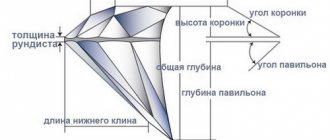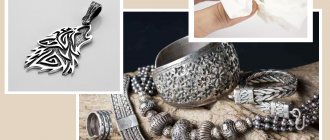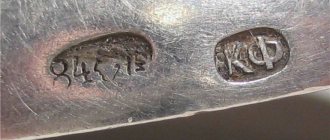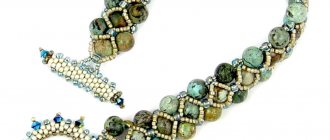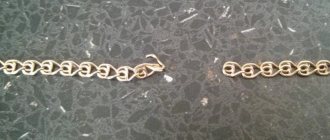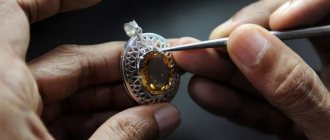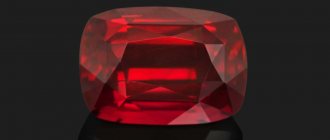Jewelry art in Rus' appeared in ancient times. In archaeological excavations, a large number of decorations from the Scythian times, created before the end of the fifteenth century, have been found. This indicates that the ancient ancestors had high skill in this matter.
Among the items found are temple rings, necklaces with cloisonné enamel (Kievan Rus period), fibula clasps, rustling pendants in the shape of birds and horses, as well as various bracelets.
Temporal rings
At that time, jewelry had a dual character. They served, at the same time, as decoration and a distinctive symbol by which the social, tribal or clan status of a person could be determined. They were the calling card of their owner.
Also, people have always tried to protect themselves from all sorts of troubles and evil spirits, thanks to amulets. Magic signs were depicted or carved on the products. At first, bronze and copper were used for such attributes, and only later they began to create magical talismans from gold and silver.
These noble metals were used to make: tiaras, necklaces, chains, rings, rings, bracelets, as well as earrings, temple jewelry, buckles and hairpins. All these items are decorations. In Rus', the most common among them were rings and rings.
Initially they looked very simple. They were made from copper and iron, and starting from the eighth century, they began to be made from silver and gold, combined with enamel and precious minerals. The most popular stones were rubies, carnelians, emeralds, corals, mother-of-pearl and pearls.
Among the various types of earrings in Rus' there were singles, doubles and triples. They were distinguished by rods with beads-pebbles strung on them. The cabbage rolls resembled one or two birds in shape, with their backs turned to each other. The hat earrings looked interesting. They were usually attached to headdresses. Also, there were bells with a large stone in the center.
Monista
Slavic craftsmen created a variety of bracelets, necklaces, monistas, and chains. A special type of chains were cassocks (cassocks). This is when pearls were strung on long ribbons or threads.
Old Russian jewelry is distinguished by a wide variety of forms and techniques used, including: granulation, filigree, chasing, casting, nielloing on silver.
The decorative finishing of the jewelry was often enamel and uncut stones processed in the form of cabochons. In addition, Russian craftsmen used Byzantine gems, local river pearls, Ceylon rubies, pink tourmalines, cherry garnets, and cornflower blue sapphires in their jewelry. Precious stones were brought from China, India, and Central Asia. Emeralds came from Egypt and Persia.
In the 16th-17th centuries, Russian jewelry craftsmen received many customers from the royal family, the capital's boyars, nobility and the highest church hierarchy. The decoration of jewelry is characterized by exceptional luxury and great splendor. Gold and silver are inlaid with bright precious stones, which are framed with colored, blackened, embossed enamel elements.
Peter I introduces fashion for jewelry
Peter the Great significantly changed the image of Russia through economic, political and cultural transformations. The country gradually became familiar with Western innovations and was rebuilt in a European way. Such changes in the Peter the Great era affected many things, including the art of jewelry.
It was in the eighteenth century that the Russian name “silver and goldsmith” was replaced by the European shortened “jeweler”. But not only the term has changed, but new trends have appeared in the life of Russian culture and art.
Peter the Great introduces a new noble costume. In 1700, he issues a decree stating that it is mandatory to wear clothes in Western European style. A new outfit required new decorations. It was during this period that tiaras, cufflinks, brooches, and buckles for dresses and shoes appeared. In Europe, these jewelry were widespread, while for Russia it was a novelty.
The main character of the eighteenth century in Russian jewelry was the precious stone. The leader among all minerals is, of course, the diamond. Now the crystals definitely begin to be cut.
Under the patronage of Peter the Great, stone deposits in Altai and the Urals are being developed. Cutting factories are also opening there. Foreign experienced jewelers are invited to Russia, including Jean Pierre Ador, Jeremiah Pozier, Johann Gottlieb Scharf. Their own masters appear who work in pan-European traditions. The French style is especially popular.
The clasp is becoming a fashionable attribute. It was placed on a necklace or necklace, in the form of a decorated clasp. The chatelaine was a decoration for a belt, on which there were many different small objects and chains. A hairpin with stones and feathers is called an aigrette. A very interesting piece of jewelry from that time was the portobouquet. It consisted of a small vase attached to a belt for fresh flowers or stylized ones - made of gold and precious crystals.
Jewelry art of the 18th century is characterized by compositional color accents of stones, where the stone acts as the main attribute in jewelry. Within the framework of the Rococo, Baroque and Classicism styles, the Russian direction is being formed.
Baroque jewelry is distinguished by bright colors and multi-colored faceted stones. The Rococo style was reflected in different hanging elements, a harmonious palette of crystals and some alignment of their dimensions.
Products in the classicist style are not so bright; on the contrary, they look calmer. They often used glass with foil to imitate colored stones. Stylization of precious minerals was also allowed in expensive jewelry. During this period, Tula steel “diamonds” and rhinestones appeared. Metal was given a secondary role. He was just a design element.
Russian jewelry art of the eighteenth century is rightfully considered the period of shining precious stones.
Ovchinnikov Pavel Akimovich
One of the most famous jewelers in Russia was Pavel Akimovich Ovchinnikov (1830-1888), a silversmith who was a serf of the Volkonsky princes from birth. From an early age, showing considerable ability in drawing, at the age of eight the gifted boy was sent as an apprentice to a gold and silver workshop that belonged to his brother Andrei Afanasyevich Ovchinnikov. It was there that the future jeweler received a good school and became an excellent craftsman.
Ovchinnikov Pavel Akimovich.
Pavel Ovchinnikov received his freedom at the age of 20, and with 1000 rubles from his wife’s dowry he started his own business, which in the future will become one of the main jewelry enterprises in Moscow. However, a full 15 years will pass before the master demonstrates his products for the first time at an exhibition of manufactured works in the capital. And these works were so good that they immediately attracted the attention of the public with their high craftsmanship and good artistic taste.
Artistic enamels by Pavel Ovchinnikov.
From that time on, Ovchinnikov’s jewelry enterprise would become dominant among participants in both All-Russian and world exhibitions. And products bearing the mark of his company will always arouse the admiration of his contemporaries, receive numerous awards for his creative approach to jewelry and are eagerly purchased by consumers. By the way, if in 1853 the annual turnover of the enterprise was 250 thousand rubles, then already in 1854 it was 1.5 million rubles.
In 1867, a landmark event took place not only for Ovchinnikov’s jewelry company, but also for Russia. For the first time, the master decided to present his products to the world community and take part in the World Exhibition in Paris, where the works of jewelry makers from more than 30 participating countries were presented. Unprecedented success awaited Pavel Ovchinnikov - he returned to Moscow with a Silver medal.
After such a triumph, Pavel Akimovich received the right to decorate his products with the state emblem and open his first store in Moscow - on the prestigious Kuznetsky Most, and a little later in St. Petersburg. The 1870s–1880s were the time of the greatest prosperity of the enterprise. And along with jewelry production, in 1871, a special school was opened at the factory to teach talented craftsmen the craft.
Tea-set. Artistic enamels by Pavel Ovchinnikov.
The company had a lot of orders at that time. Her clients were both aristocrats and crowned members of the royal family, as well as representatives of the royal courts of Europe. During the reign of Alexander III, Ovchinnikov received the status of “Supplier of the Court of His Imperial Majesty.” Diplomatic souvenirs, products for coronation and other celebrations, gifts for members of the imperial family were produced exclusively at the enterprise. Ovchinnikov’s stores were simply adored by visiting rich foreigners.
Artistic enamels by Pavel Ovchinnikov.
By the end of his life, Pavel Akimovich had many titles and regalia - a merchant of the first guild, a hereditary honorary citizen of Moscow, a manufacturing adviser, a holder of many Russian and foreign awards, and he was also known as a reasonable and grateful owner, who left a good memory of himself among their workers. The company he founded was destined to outlive its owner - Pavel Akimovich’s business was successfully continued by his sons. The enterprise existed until the events of 1917.
Revival of the “Russian style” in the 19th century
A distinctive feature of 19th-century jewelry was its mass production. Cheaper jewelry is appearing. This was due to the fact that fashion was changing very quickly, so new decorations were required.
During this period, technical and artistic performance in jewelry that came from past centuries was also preserved. Brooches, pins, medallions, cameos, tiaras fade into the background, and preference is given to products born under the influence of the romantic style. The most fashionable decoration is a chain with a stone in a frame. It was worn on the head and called “ferroniere”.
Paired bracelets, brooches, and combs appear. Romanticism had a strong impact on the artistic and aesthetic taste of Russian society. Different decorative elements are mixed in one decoration. The aesthetics of jewelry items fully coincides with pan-European standards.
In the middle of the 19th century, the national movement “historicism” was very popular in Russia in all types of art. In jewelry, craftsmen express the “Russian style.” Northern Russian river pearls are coming back into fashion.
Insects are becoming favorite decorative elements in jewelry. At this time, pendants and brooches decorated with images of flies, spiders, and beetles appeared. They were often made in the form of gold cast overlays, sometimes they were decorated with faceted precious crystals.
The fashionable motif of that time, on neck jewelry, was a coiled snake with sparkling eyes made of garnets, emeralds and diamonds.
Jewelry craftsmen began to widely use a combination of a large surface (often made of gold), with precious crystals and colored enamel. Also, they used ornamental Ural stones (malachite, jasper, rhodonite).
The desire to make products more massive led to the appearance of “blown gold”. Visually, the decoration seemed larger, but at the same time it was light in weight, and therefore not too expensive.
In Russia, in the nineteenth century, an entire jewelry industry appeared, as well as a training system. In addition to small workshops, large Russian jewelry companies, Khlebnikov, Sazikov and Faberge, appeared.
These companies use new technologies and have their own artists, which allows them to simultaneously produce a large assortment of stylish products and make individual orders for different audiences.
However, the mass production of jewelry influenced the artistic level. Not all companies had the opportunity to combine serial production of jewelry with a high technical and artistic level of their execution. Only one brand, Faberge, managed to achieve a harmonious combination in its products.
The company employed the most talented craftsmen and artists. This was one of the main components of Faberge's success, which made it possible to create impeccable jewelry: cutlery, cigarette cases, simple souvenirs, various decorations and the famous imperial Easter eggs.
First jewelry school
At the end of the 17th – beginning of the 18th century, the first school was created at the Armory Chamber. It was also called the Cabinet of the Imperial Court. It was a significant training center for domestic craftsmen. The training system there had much in common with apprenticeship in the workshops of Ancient Rus'. Visual learning predominated, but subjects such as arithmetic, literacy, and drawing were already introduced. The progress of the students was constantly monitored, the best artistic examples were periodically reviewed and selected. The workshops of the Moscow Kremlin were given so much importance that the tsar personally monitored their work: he checked the art of visiting masters, unquestioningly sent home those who did not meet the artistic requirements of the Moscow court, rewarded and increased salaries for the work he liked, and sometimes even approved the design of the object , before the master began to make it.
The special path of jewelry after the Russian Revolution
After the revolution of 1917, Russian jewelry art took a special path. Many well-known jewelry brands began to repurpose themselves. Thus, the Khlebnikov factory, which once produced jewelry at the Faberge level, begins production of processing precious stones and metals for technical purposes.
was considered the pride of Russian stone cutting. After the revolution, the production of sharpening stones was established there. The famous Faberge closed.
It seemed that the art of jewelry had disappeared forever. But life makes its own adjustments. Gradually the need for jewelry appears. The production of jewelry is carried out by the state. They are made mainly according to samples from the pre-revolutionary period. At this time, the technical level of execution that was accumulated earlier decreases, which significantly impoverishes the jewelry.
But it is possible to maintain the production of traditional handicraft centers engaged in fittings, chain mail weaving, silversmithing, and filigree jewelry. Almost no jewelry was made there, but the craftsmen managed to maintain professional jewelry skills.
Gustav Klingert
Klingert Gustav Gustavovich (1836-1921).
This galaxy also includes the outstanding jeweler Gustav Klingert, a German by birth who has lived in the Russian capital all his life. His father, a jeweler by profession, moved to Russia at the beginning of the 19th century and, settling in Moscow, opened his own enterprise. Gustav was involved in the family business from childhood. In 1865, he opened his own factory, which produced mainly silver cutlery, sometimes effectively combining silver with glass or crystal. The factory's products enjoyed great success and were awarded medals at international exhibitions in London, Paris, Chicago, and Antwerp.
Part of a tea or coffee service from 1896–1908. Klingert Gustav.
New Russian jewelry art
After a long break, in the mid-thirties, the Kostroma jewelry artel produced a small batch of silver-gilded items. This was the beginning of the revival of the Russian jewelry industry. Small workshops are opened in Moscow, Yekaterinburg (Sverdlovsk), St. Petersburg (Leningrad), then jewelry production is launched in other cities.
It is interesting that at that time there were no universities that trained jewelry artists. Therefore, jewelry was created by artistic designers, not artisans. They made copies of old designs from gold with precious stones and diamonds. New jewelry was perceived more as a symbol of wealth than a work of art.
It was only in the mid-fifties that designer jewelry began to be made. The main goal of artists is self-expression. To reveal a creative idea, you can use any processing and techniques, as well as work with any material. This is how exclusive single copies appear, which are often exhibited in museums, galleries and exhibition halls.
One of the pioneers of designer art is Düsseldorf Friedrich Becker, who is now considered a classic of twentieth-century jewelry. He boldly designed new forms of products.
Estonian jewelers made a great contribution to the development of designer jewelry. They turned to national themes, symbols and ornaments, but at the same time, they did not copy the past, but conveyed a modern view of it.
In the sixties, jewelry artists began to re-master ancient jewelry craftsmanship. They work on historical originals, museum exhibits, studying the Empire, Baroque, and Art Nouveau styles.
Secrets of Russian enamel
Works of enamel art in the second half of the 19th century began to be distinguished by the exceptional variety of material processing and complexity of production. Craftsmen began to use the most complex enamel techniques, namely cloisonné, champlevé, and luminous. Interestingly, there are examples in which all these techniques were used at the same time when decorating them.
Artistic enamels.
For reference: Enamel is a glassy mass that is colored with metal oxides in various colors and shades. Artistic painting with enamel on metal involved a special technology of applying various designs to the metal surface of the product, which, after firing, were sanded and polished to a shine. Depending on the technique of applying and fixing the enamel on the surface, it goes by different names: champlevé, filigree, cloisonné, painted, relief, glazed, transparent and opaque.
It is also worth noting that the most complex and labor-intensive technical design is cloisonné enamel. To make it, they took, for example, an object made of a thin silver, gold or copper plate, on which the outline of the future image was scratched, engraved or cut through. Then a filigree or thin strip of metal was soldered along this contour, obtaining a relief image from cells of different shapes.
Artistic enamels.
When the design was completely applied, each cell was filled with enamels of different colors and shades to the very edges of the partitions. Then the product was fired, after which it was ground and polished so that the enamel and the top of the partitions were in the same plane. The result was a multi-colored enamel image, shining like precious stones, with a clear contour pattern of metal lines.
